Early on, people recorded history even if they didn’t yet understand the importance of doing so. Cave art, which was primarily used for communication, symbolic, and religious purposes, now gives us an insight into the lifestyle of our ancestors. The writings of the king's names on the Palermo Stone in Egypt are already one of the earliest examples of intentional historical recordings. Even though these aren’t typical ways we document the past nowadays, they still provide us with ample information about it.
Sadly, the amount of recorded history we produced over thousands of years makes it easy to remember the pivotal moments and forget the others. That’s why today we’re featuring historical events and stories from the Instagram account “Past Preserved”—to bring light to happenings from the past people might have forgotten. Scroll down to find them below, and don’t forget to upvote the ones that definitely shouldn’t fade from our memory.
While you're at it, make sure to check out a conversation with historian Sean Stewart, who kindly agreed to chat with us about the preservation of history.
#1
Stubby was found wandering the grounds of the Yale University campus in New Haven, Connecticut, in July 1917, while members of the 102nd Infantry were training. He hung around as the men drilled and one soldier in particular, Corporal James Robert Conroy developed a fondness for him. Stubby served with the 102nd Infantry Regiment in the trenches in France for 18 months and participated in four offensives and 17 battles. In his first year of battle, Stubby was injured by mustard gas. After he recovered, he returned with a specially designed gas mask to protect him. He thus learned to warn his unit of mustard gas attacks, locate wounded soldiers in no man's land, and since he could hear the whine of incoming artillery shells before humans-became very adept at alerting his unit when to duck for cover. He saved his regiment from surprise mustard gas attacks, found and comforted the wounded, and allegedly once caught a German soldier by the seat of his pants, holding him there until American soldiers found him. After returning home, Stubby became a celebrity and marched in, and normally led, many parades across the country. He met Presidents Woodrow Wilson, Calvin Coolidge, and Warren G. Harding. He died in his sleep in March 1926: his remains are at the Smithsonian National Museum of American History

Image credits: pastpreserved
#2
Ludwig van Beethoven, one of the greatest composers in history, lost his hearing in his late 20s and was almost completely deaf by the time he composed many of his masterpieces. Determined to continue his work, Beethoven discovered he could “hear” his music through bone conduction. By biting a metal rod or stick connected to his piano, he felt the vibrations travel through his jawbone to his inner ear, allowing him to sense the pitch and tone of his compositions. This innovative method enabled Beethoven to create some of his most iconic works, including his Ninth Symphony. His use of bone conduction not only showcased his resilience but also highlighted his extraordinary ability to adapt in the face of adversity

Image credits: pastpreserved
#3
Freddie Mercury’s dedication to his music never wavered, even in his final days. During his last recording sessions with Queen, he was so weak from illness that he could only sing a few lines at a time before needing to rest. Despite the immense physical toll, he insisted on pushing through, determined to leave behind as much music as possible. His final vocals, recorded for Made in Heaven, stand as a testament to his relentless passion and artistic spirit. Though his health was rapidly declining, Mercury remained focused on his craft, telling his bandmates, “I’ll sing it, darling. I’ll give it my all.” His voice, though fragile, carried the same power and emotion that had defined his legendary career. Even in his final moments, he proved that his love for music was stronger than anything—even the illness that was taking him away

Image credits: pastpreserved
When talking about history in general, historian Sean Stewart says, "History can be defined in many ways, but for me, I think it's useful to mark a distinction between the concept of "the past" and the concept of "history." The past is simply factually what happened. Most of this is lost to time. Things aren't recorded, or the records are lost," he explained.
"Consider your own past; can you remember factually what you did at 10:00 on the 8th of June, 2015? If there is no record of it, then probably not. Expand this to the rest of humanity."
#4
Vincent van Gogh’s artistic career might never have flourished without the unwavering support of his younger brother, Theo. Theo provided the financial stability and emotional encouragement that allowed Vincent to focus entirely on his art, despite his struggles. Tragically, Vincent passed away in 1890, and Theo followed just six months later after battling his own health issues.The bond between the brothers was profound, and they now rest side by side in the cemetery of Auvers-sur-Oise, France. Their connection is immortalized not only through Vincent’s masterpieces but also through the letters they exchanged, which reveal the depth of their relationship
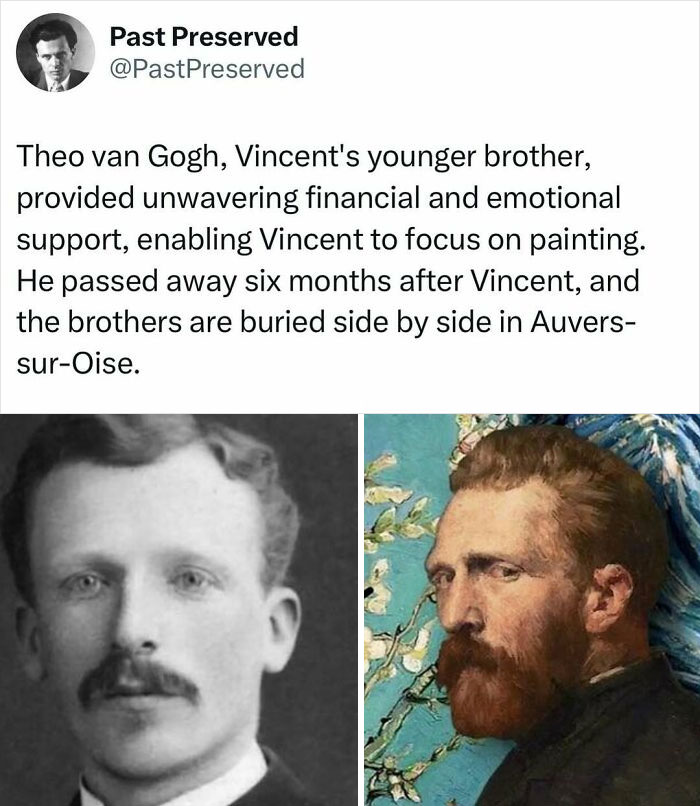
Image credits: pastpreserved
#5
In the early 1970s, Sylvester Stallone was struggling to make ends meet as an aspiring actor. In 1971, Stallone sold his beloved bullmastiff, Butkus, for $40 outside a 7-Eleven, as he could no longer afford to feed him. Stallone was hugely affected by having to part with his best friend - Butkus had been his loyal companion during his most difficult times, offering him comfort as he lived in a small, roach-infested apartment. Four long years later, after Stallone’s screenplay for Rocky sold and his career finally began to take off, he immediately sought to buy Butkus back. The new owner, knowing Stallone’s situation, demanded $15,000, which Stallone paid without hesitation. The two were reunited in 1975, and Butkus even went on to star in the first two Rocky films alongside Stallone. They remained inseparable until Butkus passed away in 1981.
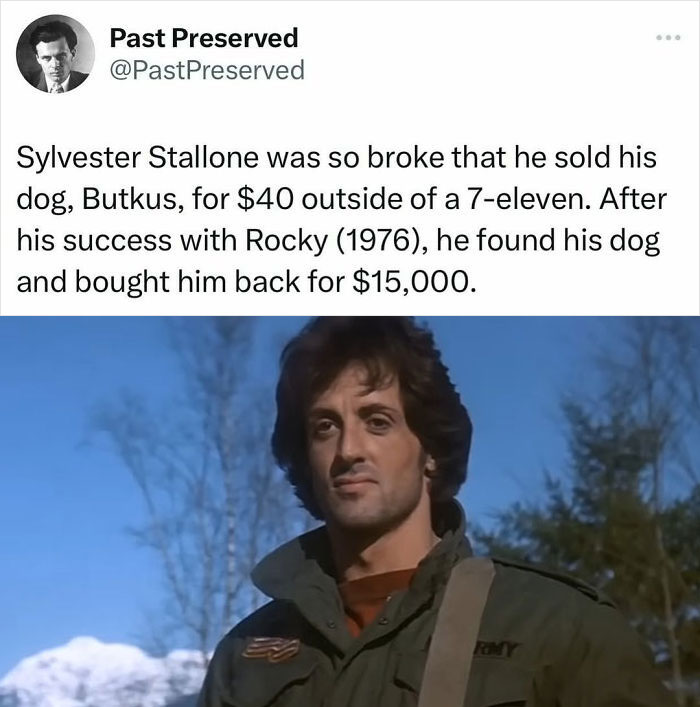
Image credits: pastpreserved
#6
Tsutomu Yamaguchi was in Hiroshima on August 6, 1945, when the first atomic b**b was dropped. He survived the blast, suffering burns and temporary blindness, but managed to return to his hometown of Nagasaki just in time for the second atomic b**b on August 9. Remarkably, Yamaguchi survived both explosions, making him the only officially recognized survivor of both atomic bombings. Despite the immense trauma, Yamaguchi lived to the age of 93 and became a passionate advocate for nuclear disarmament. His incredible story of survival serves as both a testament to human resilience and a sobering reminder of the devastating power of nuclear weapons.

Image credits: pastpreserved
Fascinated with the distinction between history and the past, he continued contemplating. "The past is like the past simple tense in English. It states a bare fact about the past. "I ate breakfast at 900." Ok, fine. History, by contrast, is more like the present perfect tense. It's essentially a present tense that references the past, but it's really about the present/future," he said.
"So, "I have eaten breakfast." The eating happened in the past, but the real point of the sentence can be the unspoken but understood "....and so now we can leave to go to work." Or "....and so I'm not hungry now." It's really about our actions NOW."
#7
Judy, a purebred liver-and-white English Pointer, became the only animal officially recognized as a prisoner of war during World War II. Her story began in 1936 when she was adopted as a ship mascot by the crew of the HMS Gnat, a British gunboat stationed on the Yangtze River in China. Judy quickly became beloved for alerting the crew to danger, especially during encounters with Japanese forces. In 1942, after her ship was sunk, Judy and her crew were captured by Japanese forces and sent to a brutal prisoner of war camp in Sumatra. There, she saved lives by distracting guards and finding water for her fellow prisoners. Frank Williams, a POW who cared for her, registered Judy as a prisoner of war to protect her from e*******n. After the war, she was awarded the Dickin Medal, the animal equivalent of the Victoria Cross, and lived happily with Williams, cementing her legacy as a true war hero.

Image credits: pastpreserved
#8
Terry Fox was a Canadian athlete and cancer activist who became a national hero for his inspiring “Marathon of Hope.” In 1980, after losing his right leg to osteosarcoma (a form of bone cancer), Terry set out to run across Canada to raise money and awareness for cancer research. Running with a prosthetic leg, he covered an average of 26 miles per day, the equivalent of a marathon, starting in St. John’s, Newfoundland. Terry’s journey captured the hearts of Canadians, but after running 3,339 miles over 143 days, his cancer returned, forcing him to stop in Thunder Bay, Ontario. Despite not completing his goal of running across the country, Terry’s legacy endures. The Terry Fox Foundation has since raised over $850 million for cancer research, and annual Terry Fox Runs are held around the world in his honor. His courage, determination, and selflessness have made him a symbol of hope and perseverance in the fight against cancer

Image credits: pastpreserved
#9
In the final years of his life, Albert Einstein remained engrossed in his work, still searching for a unified field theory that could reconcile the laws of physics. Though he had stepped back from public life, he continued to correspond with colleagues and remained engrossed in his studies til the end. By 1955, his health had worsened due to an abdominal aortic aneurysm. Refusing surgery, Einstein passed away on April 18, 1955, at the age of 76 in Princeton Hospital. While reporters flocked to the hospital, Life magazine photographer Ralph Morse chose a different path. Instead of joining the media frenzy, Morse went to Einstein’s office at the Institute for Advanced Study. There, he captured poignant photos of Einstein’s desk, just as he had left it—papers and books scattered in disarray, untouched since his last moments of work. These images, haunting and intimate, immortalized the quiet brilliance of Einstein’s life, symbolizing his relentless pursuit of knowledge until the very end.
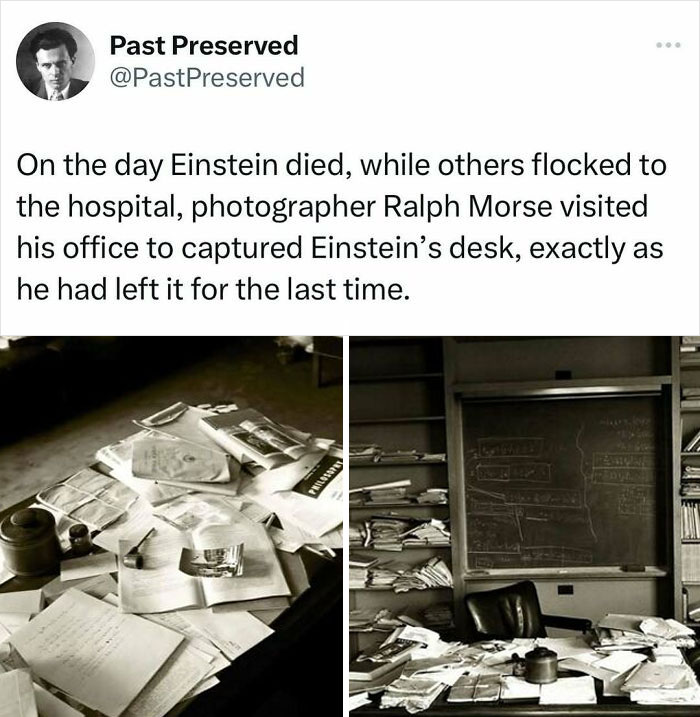
Image credits: pastpreserved
Surprisingly, when we asked Stewart about the historical event people should know about more, none in particular came to his mind. "Most is lost. It depends, on who YOU are, and what YOU believe is important NOW. The stories you find in the past will then influence which stories (of those that remain known to us) you will teach, make films about, or write about," he told Bored Panda.
#10
Mary Shelley, best known as the author of Frankenstein, kept a macabre memento after her husband, poet Percy Bysshe Shelley, passed away in 1822. Percy lost his life in a sailing accident, and when his body was cremated, his heart did not fully burn, possibly due to calcification from an earlier illness. Mary kept the preserved heart wrapped in his own poetry and stored it in her writing desk for the rest of her life. The heart was eventually buried alongside Mary’s son, Percy Florence, after her passing in 1851. The story is a haunting glimpse into the gothic life of the woman who created one of literature’s most enduring monsters

Image credits: pastpreserved
#11
At the 1973 Academy Awards, Marlon Brando won Best Actor for The Godfather, but he refused to accept the Oscar. Instead of attending the ceremony, he sent Apache actress and activist Sacheen Littlefeather to decline the award on his behalf. She took the stage and explained that Brando was boycotting in protest of Hollywood’s negative portrayal of Native Americans in film and television, as well as in response to the ongoing standoff at Wounded Knee between federal agents and members of the American Indian Movement. Littlefeather’s speech was met with a mix of applause and boos from the audience, and she later revealed that security had to prevent actor John Wayne from forcibly removing her from the stage. Brando’s protest became one of the most famous moments in Oscar history, sparking conversations about Native American representation in media. However, Littlefeather faced industry backlash, with some questioning her Native heritage—claims she firmly denied throughout her life. In 2022, the Academy formally apologized to her for the mistreatment she endured following the speech
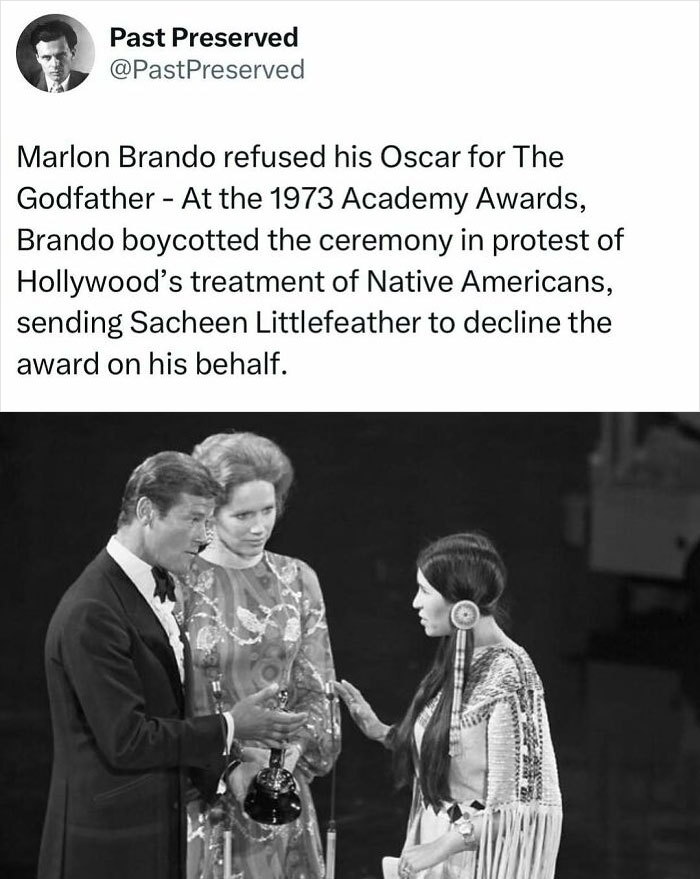
Image credits: pastpreserved
#12
Pablo Picasso’s first self-portrait, painted in 1896 when he was just 15, reflects his early mastery of traditional techniques. Nearly eight decades later, his final self-portrait, created in 1972 at the age of 90, offers a raw and emotional glimpse into his confrontation with mortality. These works bookend the incredible evolution of one of history’s most iconic artists
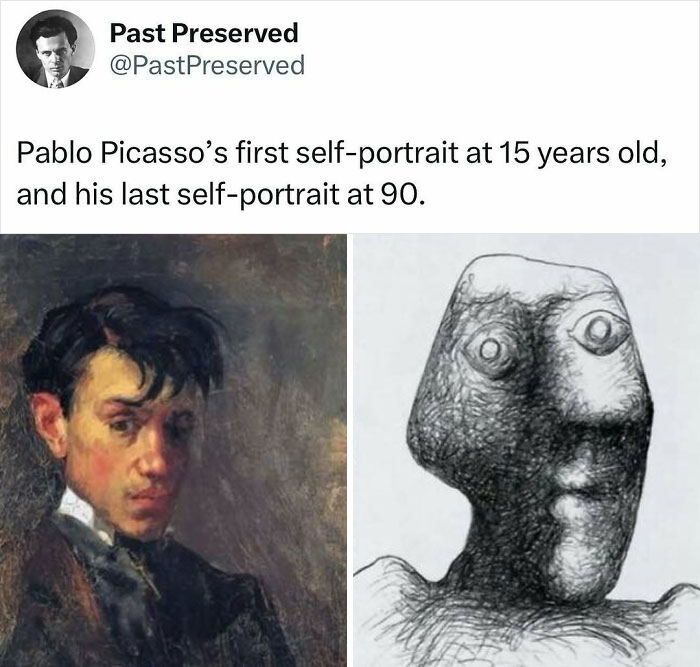
Image credits: pastpreserved
Writer and philosopher George Santayana once wrote, “Those who cannot remember the past are condemned to repeat it.” However, Stewart doesn't seem to agree with it, as both those who learn and don't learn about it are doomed to repeat it.
#13
David Bowie’s unique eye appearance was the result of a teenage fight, not a natural eye color difference. At 15, Bowie got into a scuffle with friend George Underwood over a girl, and Underwood punched him in the left eye. The blow permanently damaged Bowie’s pupil, causing it to remain dilated—a condition known as anisocoria—giving the appearance of two different eye colors. This eye injury became one of Bowie’s most striking features, adding to his mysterious and unconventional image. Despite the injury, Bowie and Underwood remained close friends, and Bowie later credited Underwood with inspiring some of his iconic style choices that helped shape his persona

Image credits: pastpreserved
#14
Salvador Dalí, known for his eccentricities, once used his art as a form of payment at restaurants. Rather than settle his bills with cash, he would often sketch on the back of his meal checks, leaving behind unique, surreal doodles. The restaurant owners, recognizing the value of his work, accepted these sketches as payment instead of money. This practice reflected Dalí’s belief in the intrinsic value of his art, even in everyday situations. By transforming a simple restaurant receipt into a piece of his surrealist world, Dalí turned mundane transactions into a statement about the cultural and financial worth of art during his time.
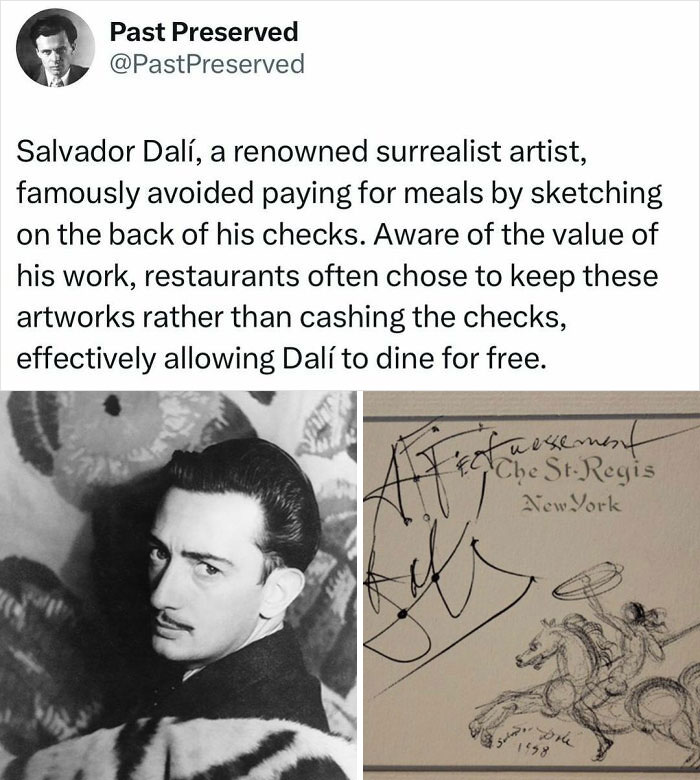
Image credits: pastpreserved
#15
During World War II, a Great Dane named Juliana became a canine hero. In 1941, a German incendiary b**b landed in her owner’s home in England. Without hesitation, Juliana urinated on the device, extinguishing it before it could cause an explosion. Her quick thinking saved lives and earned her a medal for bravery from the Blue Cross, an animal welfare charity. Juliana’s story doesn’t end there—she received a second Blue Cross Medal in 1944 for alerting her owners to a fire in their shop. While her first act of heroism is often recounted with humor, it underscores the incredible instincts and intelligence of animals, even in the face of war.

Image credits: pastpreserved
"I say, [historical amnesia] happens all the time. The academic art of history, after all, is rummaging around in old archives trying to "remember" and bring to a wider audience today things that were once well-known by previous generations. We'd just forgotten it over the centuries. And ultimately, knowing things always depends on what you wish to accomplish in today's world. One thing is certain...knowing things in and of itself is not a preventative; we know all about several historical genocides, but that does very little to stop them from happening again and again."
#16
One of the earliest depictions of Jesus, found in a 200 AD engraving, wasn’t a tribute but a mockery. It shows a man worshiping a crucified figure with a donkey’s head, likely a satirical jab at early Christians.

Image credits: pastpreserved
#17
The phrase “mad as a hatter” has its origins in the 18th and 19th centuries, linked to the dangerous working conditions of hat makers. During this time, many hatters used mercury nitrate in the process of curing felt for hats. Prolonged exposure to mercury caused a condition now known as mercury poisoning, which affected the nervous system and led to symptoms such as tremors, mood swings, and erratic behavior. These effects were so common among hat makers that people began associating their unusual behavior with the profession, coining the term “mad as a hatter.” Though often linked to Lewis Carroll’s Alice’s Adventures in Wonderland, the phrase was in use well before the book’s publication
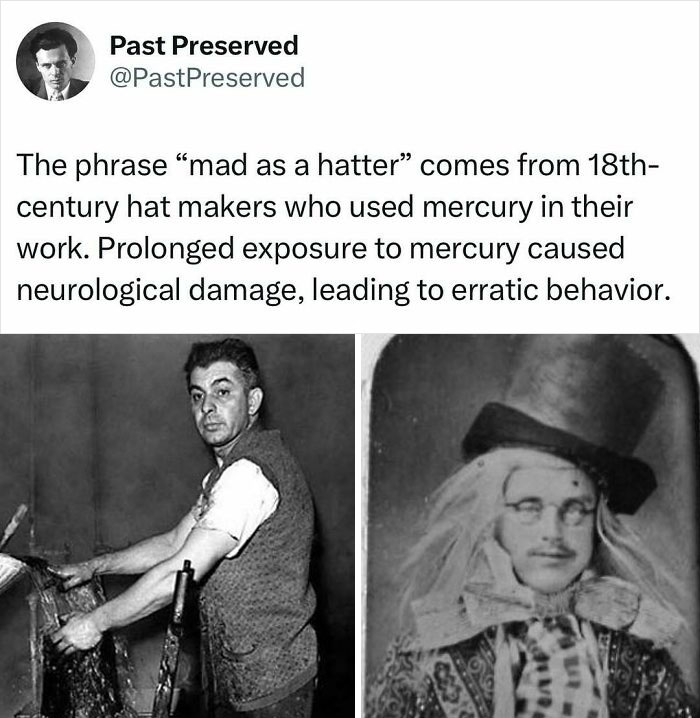
Image credits: pastpreserved
#18
In 1839, Robert Cornelius, an amateur chemist and photography enthusiast, captured what is widely regarded as the first photographic self-portrait, or “selfie.” Using a daguerreotype process, Cornelius positioned himself in front of his homemade camera in his family’s lamp store in Philadelphia. After removing the lens cap, he remained still for several minutes to expose the plate and then wrote on the back of the final image: “The first light picture ever taken”
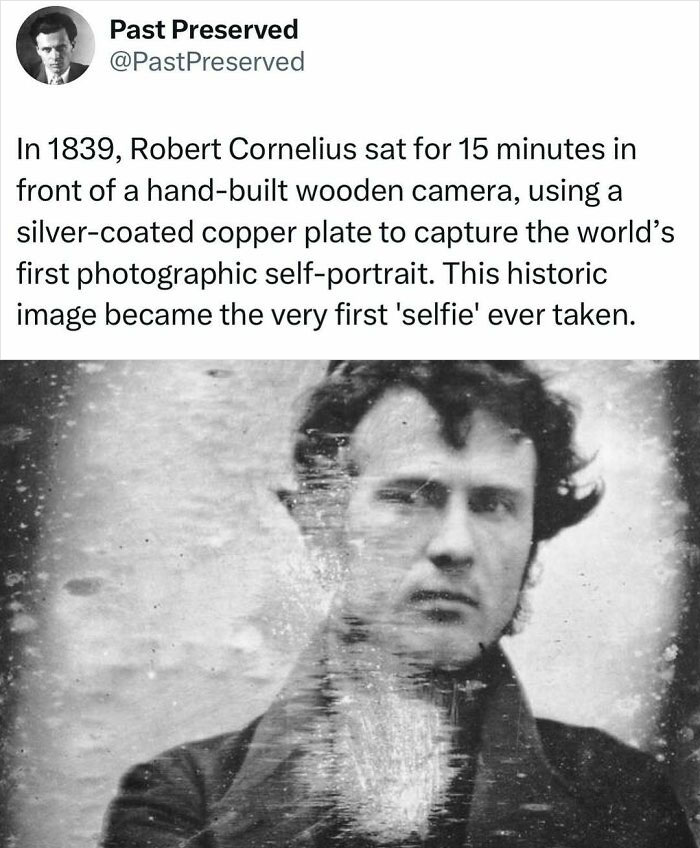
Image credits: pastpreserved
"Given that most of the past is lost (not written down, or the objects have been lost, or the records changed or destroyed), then the cost of forgetting the past is known to us....we're living it now, and have always been living it. Before the invention of writing around 4k years ago, stories (history, the past) were kept alive only through oral tradition. As you can imagine, for over 100,000 years, we have been working as a species without anything like the modern concept of history. Most of our species' existence has been lived without remembering documented history, as we understand it today. We survived, somehow or other," he further explained.
#19
During World War II, Queen Elizabeth II broke royal tradition by joining the Auxiliary Territorial Service, where she trained as a mechanic and military truck driver. At just 18 years old, she learned to repair engines, change tires, and drive heavy vehicles—earning the nickname “Princess Auto Mechanic.” This hands-on experience made her the only British monarch with mechanical training, showcasing her dedication to serving alongside her people during a time of crisis. Her service in the ATS was part of a broader effort to contribute to the war, despite her royal status. Unlike other monarchs who remained largely behind the scenes, she actively participated in the war effort, symbolizing resilience and duty. Decades later, she remained passionate about driving, often taking the wheel of her Land Rover well into her 90s—without ever needing a driver’s license

Image credits: pastpreserved
#20
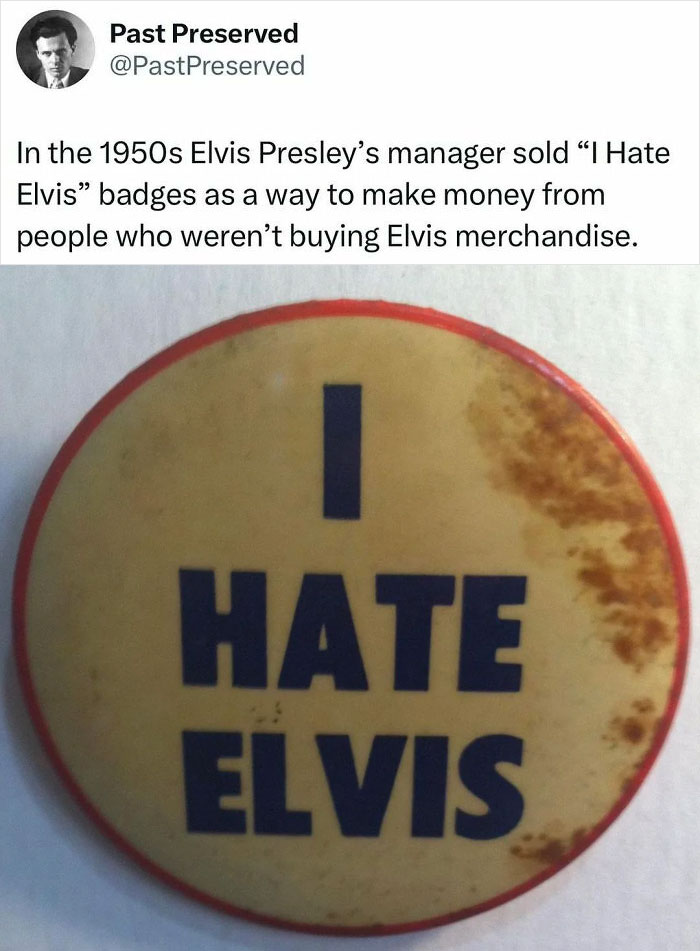
Image credits: pastpreserved
#21
Wojtek, a bear adopted by the Polish Army during World War II, became an iconic member of the 22nd Artillery Supply Company. Found as a cub in Iran in 1942, he was trained by soldiers to carry artillery shells and supplies, and even participated in the Battle of Monte Cassino in 1944. Due to his contributions, Wojtek was officially enlisted as a soldier, given a rank, and issued a service number. Wojtek’s unusual military service included enjoying beer with the troops, and he became a beloved mascot. After the war, he was relocated to the Edinburgh Zoo in Scotland, where he lived until his death in 1963. His story remains a testament to the bond between soldiers and the animals they encountered during wartime.
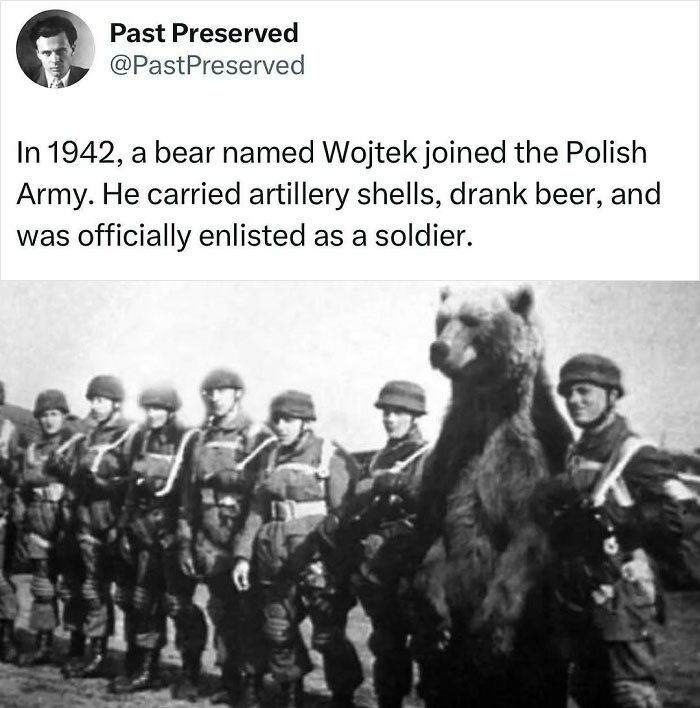
Image credits: pastpreserved
Lastly, he says that the cost of forgetting has to be understood properly. "If you don't know something happened, how does your complete ignorance of it affect you? Knowing it might enhance your life, but being ignorant of which Shogun was in charge in Japan 300 years ago will probably not stop you from living a full life."
#22
When Sony released the first Walkman in 1979, it came with an interesting feature: two headphone jacks. The designers believed that listening to music in public could be seen as antisocial or rude, so they included the second jack to encourage sharing the experience with a friend. Along with this, the Walkman came with a “hotline” button, which temporarily lowered the volume so users could talk without removing their headphones. However, the feature of two headphone jacks wasn’t widely used as Sony expected. People preferred the personal, solitary experience the Walkman provided, which was its main appeal. As a result, later models removed the second headphone jack, focusing instead on enhancing the user’s individual listening experience. This change marked a shift in how people interacted with portable music, embracing the Walkman as a personal device.

Image credits: pastpreserved
#23
Ancient Roman concrete has proven to be far more durable than most modern-day concrete. Unlike modern mixtures that degrade over time, Roman concrete is known for its ability to actually strengthen when exposed to seawater, a quality found in structures like the Pantheon and coastal piers that have stood for nearly two millennia. The secret lies in a unique blend of volcanic ash (often collected from Mount Vesuvius), lime, and seawater. These minerals react chemically over time to form new crystalline structures, fortifying the strength and durability of the concrete itself. This “self-healing” property allowed Roman marine structures to endure and even thrive despite millennia of weathering, leaving modern scientists studying its composition as they seek to replicate its strength for future construction.

Image credits: pastpreserved
#24
Methuselah, a Great Basin bristlecone pine (Pinus longaeva), is the oldest known living tree in the world, located in California’s White Mountains. At over 4,800 years old, its age has been confirmed through tree-ring dating. To protect it from vandalism, the U.S. Forest Service keeps its exact location secret, ensuring the tree’s survival. Methuselah’s longevity highlights the resilience of bristlecone pines, which thrive in harsh, high-altitude environments. Despite extreme weather, it continues to grow slowly. While Methuselah holds the record, other bristlecone pines in the area are also ancient, some living for over 4,000 years, emphasizing the need to safeguard such natural wonders.

Image credits: pastpreserved
#25
In 1914, Sir Ernest Shackleton set out on the Imperial Trans-Antarctic Expedition, aiming to become the first to cross the Antarctic continent. However, his ship, *Endurance*, became trapped in thick pack ice in the Weddell Sea before even reaching the continent. For nearly two years, Shackleton and his 27-man crew endured brutal conditions after the ship was crushed by the ice and sank in 1915. The crew set up camp on the drifting ice floes, hoping for rescue, but as conditions worsened, they embarked on an extraordinary journey. They used lifeboats to reach Elephant Island, where they were still isolated from help. Shackleton and five others then made a daring 800-mile journey in a small open boat, the *James Caird*, to South Georgia Island. Despite treacherous seas and near-impossible navigation, they reached the island and hiked across its mountainous terrain to find help. After several failed attempts, Shackleton finally managed to rescue the entire crew from Elephant Island in August 1916—without a single loss of life. The expedition, though a failure in its original goal, became one of the greatest stories of leadership and survival in polar exploration history.
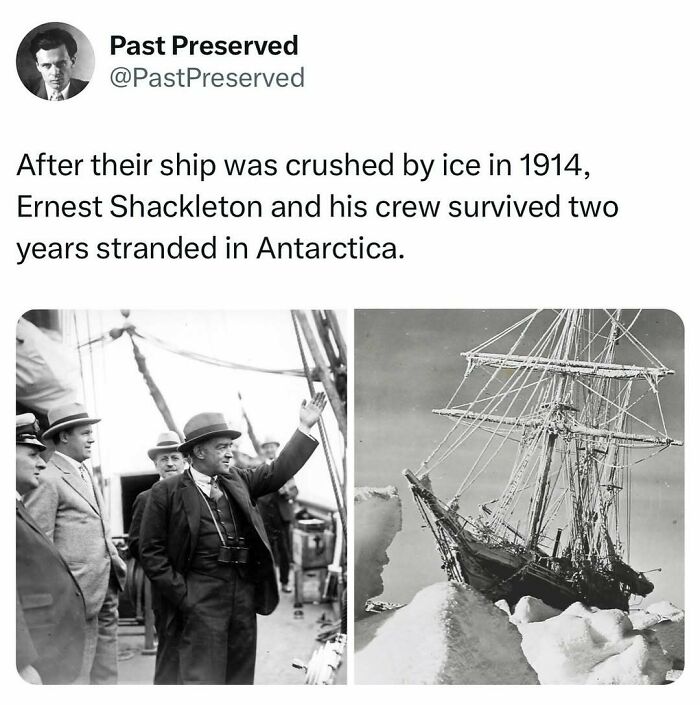
Image credits: pastpreserved
#26
In 2007, Tennessee death row inmate Philip Workman made a surprising final request before his e*******n. Convicted of taking the life of a police officer during a robbery in 1981, Workman declined a last meal for himself and instead asked for a large vegetarian pizza to be donated to a local homeless person. Though prison officials denied his request, news of his gesture spread, inspiring people across the country to donate pizzas to homeless shelters in his honor. Workman’s request became a symbol of compassion and sparked conversations about redemption and humanity, even in the final moments of life. This unexpected act left a lasting legacy beyond his controversial case

Image credits: pastpreserved
#27
Bologna, Italy, is famous for its medieval towers, which once numbered over 100 in the 12th and 13th centuries. Built by wealthy families as symbols of power, these towers also served defensive purposes. Today, fewer than 20 remain, with the most iconic being the Asinelli and Garisenda towers. The Asinelli Tower, at 97.2 meters (318 feet), is the tallest leaning medieval tower in the world, while the shorter Garisenda leans dramatically due to foundational issues. These towers rose alongside Bologna’s prominence as a center of trade and education. While many were demolished or repurposed, the Asinelli Tower was preserved and used as a prison and lookout in the 14th century. Visitors today can climb its 498 steps for stunning views of the city and the Emilia-Romagna region. These remaining towers stand as reminders of Bologna’s competitive city-state era, where towering structures displayed wealth and influence

Image credits: pastpreserved
#28
Marie Curie was a pioneering physicist and chemist who made groundbreaking discoveries in radioactivity. She was the first woman to win a Nobel Prize and remains the only person to have won in two different scientific fields—Physics in 1903 (shared with her husband, Pierre Curie, and Henri Becquerel) and Chemistry in 1911 for her discovery of radium and polonium. Her research on radioactive elements revolutionized medicine and physics, laying the foundation for advancements in cancer treatment and nuclear energy. However, her extensive work with radioactive materials, often without proper protection, ultimately led to her death from aplastic anemia in 1934, a condition linked to prolonged radiation exposure. Curie’s research materials, including her notebooks, are still highly radioactive due to prolonged exposure to radium. These documents, housed at the Bibliothèque Nationale de France, are stored in lead-lined boxes to protect against radiation, and anyone wishing to handle them must wear protective gear and sign a waiver. The radiation levels are expected to remain dangerous for another 1,500 years, as radium-226, one of the primary contaminants, has a half-life of 1,600 years. Despite this, Curie’s legacy endures in modern science, and her discoveries continue to influence medicine, physics, and nuclear research today
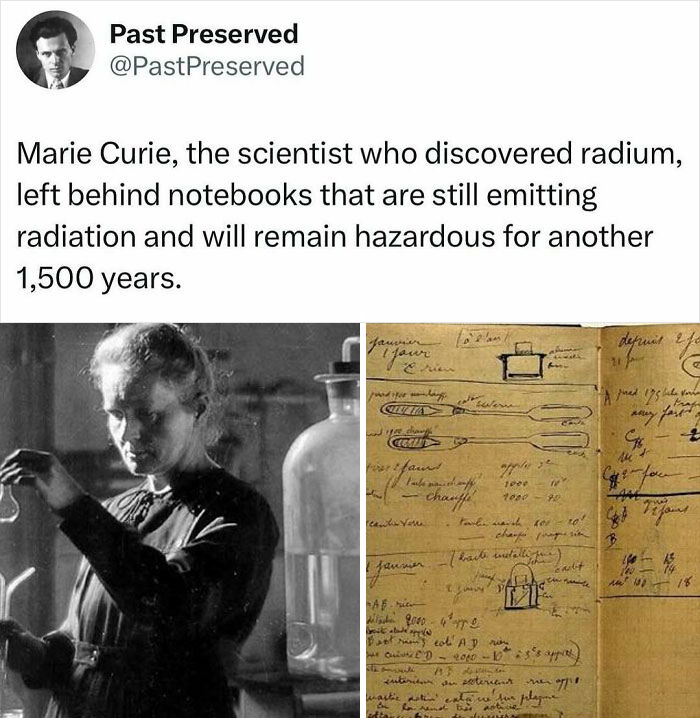
Image credits: pastpreserved
#29
The 1970 whale explosion, also known as the Exploding Whale Incident, took place in Florence, Oregon, when local authorities decided to use dynamite to dispose of a 45-foot, 8-ton beached s***m whale. Officials believed the explosion would send the remains into the ocean, leaving scavengers to clean up the rest. However, the plan went disastrously wrong when the blast sent massive chunks of whale blubber flying over 800 feet, damaging cars, smashing windows, and nearly injuring bystanders. Despite the effort, much of the whale remained on the beach, and the incident became infamous for its bizarre and unintended consequences
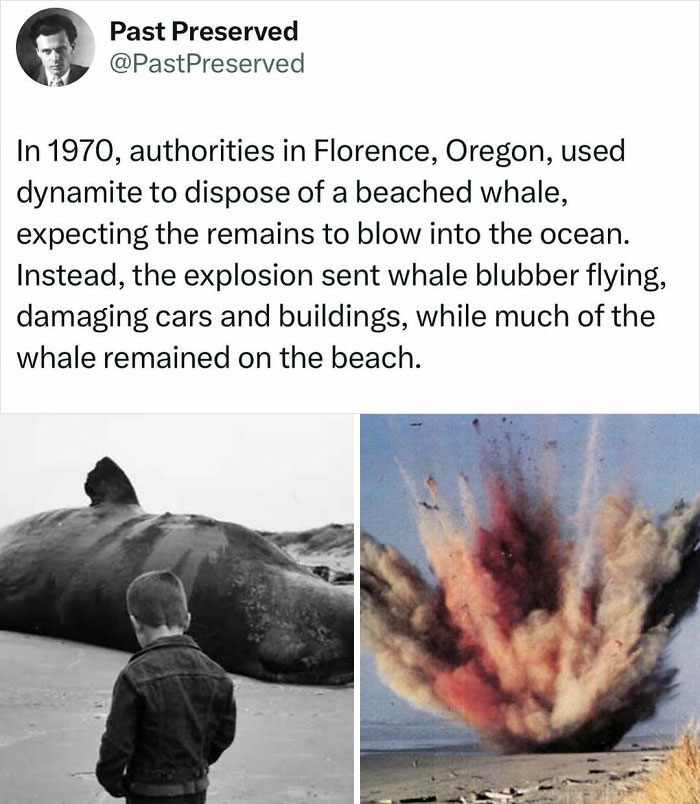
Image credits: pastpreserved
#30
Nikola Tesla was a pioneering inventor best known for developing the alternating current (AC) electrical system, which transformed how we use and distribute power today. He also made significant contributions to radio, wireless technology, and early robotics, earning him a reputation as one of history’s most innovative minds. Although he never married and largely avoided personal relationships, Tesla had a deep affection for pigeons, frequently feeding them in New York parks. He formed a unique bond with a particular white pigeon, claiming he loved her in a profound way. Tesla devotedly cared for this pigeon, even nursing her through illness, finding comfort and companionship in their connection amid his isolated and work-focused life
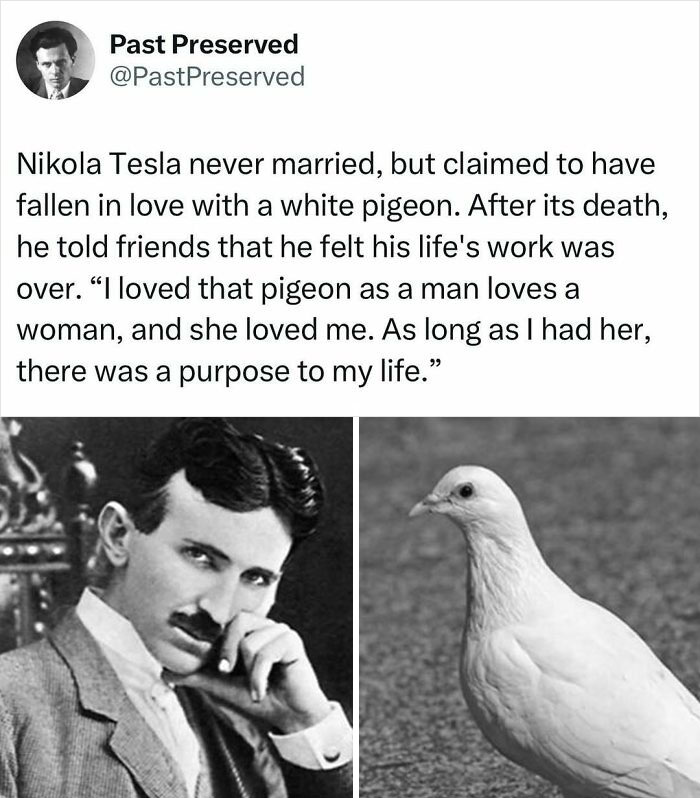
Image credits: pastpreserved







